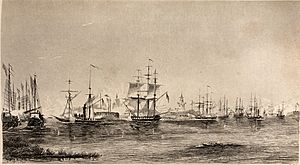Battle of Woosung facts for kids
Quick facts for kids Battle of Woosung |
|||||||
|---|---|---|---|---|---|---|---|
| Part of the First Opium War | |||||||
 Battle of Woosung |
|||||||
|
|||||||
| Belligerents | |||||||
| Commanders and leaders | |||||||
| Hugh Gough William Parker |
Chen Huacheng † | ||||||
| Strength | |||||||
| 14 ships | 19 ships 4,000–5,000 troops |
||||||
| Casualties and losses | |||||||
| 3 killed 25 wounded |
Hundreds killed or wounded 250 guns captured |
||||||
The Battle of Wusong (Woosung) was a big fight between British and Chinese forces. It happened on June 16, 1842, near the Wusong River in China. This battle was part of the First Opium War. The British won, which helped them take over the nearby cities of Wusong and Baoshan. This victory then opened the way for them to capture Shanghai just a few days later on June 19.
Contents
Why This Battle Was Important
The British wanted to capture Shanghai. This city was only about 19 kilometers (12 miles) from Wusong. By taking Shanghai, the British hoped to stop tax money from reaching the Chinese government in Peking (now Beijing). This would put pressure on China to agree to their demands and end the war. The British also needed to win quickly. They worried about their soldiers getting sick and about people back home in Britain losing support for the war.
The Battle Begins
On June 13, 1842, a British warship called HMS Cornwallis and other British ships arrived near Wusong. They got ready to attack. The main attack started on June 16. The Cornwallis and other warships moved closer to the shore. They began firing their cannons at the Chinese defenses. Other ships, carrying soldiers, stayed a bit further out at sea.
The Chinese had strong defenses. They had three miles of forts along the north side of the river. These forts fired back at the British ships. Some British soldiers were hurt. But after about two hours, the British ships' powerful cannons silenced the Chinese guns.
Taking the Forts
After the Chinese cannons stopped firing, small boats were lowered from the British warships. These boats carried Royal Marines and special groups of sailors. They landed on shore and quickly took control of the Chinese forts. They made the Chinese cannons unusable by "spiking" them. This meant putting a spike into the firing hole so the gun couldn't be used again. The British soldiers held these positions. They waited for the main group of soldiers to arrive from the ships offshore.
Most of the Chinese soldiers ran away during the battle. However, the Chinese commander, Chen Huacheng, kept fighting bravely. He fought until he was killed. After he died, his close friend, Liu Guobiao, carried Chen's body away. He hid it in some tall grass so the British wouldn't find it.
What Happened Next
By the evening, the British had full control of Wusong. Their troops then started moving towards Shanghai. Some soldiers and sailors marched along the riverbanks. Others traveled in steamships that pulled smaller boats. The only resistance they met was from one Chinese fort along the river. The British Navy quickly silenced this fort with their cannons.
By June 18, the British forces reached Shanghai. They silenced another fort just outside the city. The next day, June 19, the British took over Shanghai with very little fighting.
Images for kids




